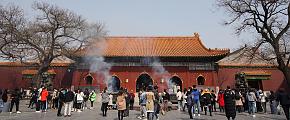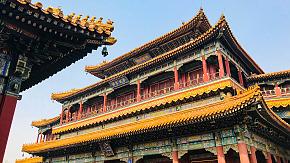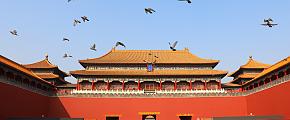Beijing Qing Dynasty Imperial Tombs
To include a visit to the Qing Dynasty imperial tombs in your Beijing tours is a great way to experience the comprehensiveness of China's history and ancient imperial culture.
The Qing dynasty (1644-1911) was the last feudal dynasty in China. The Qing Dynasty Emperors needed to be buried in places worthy of their status and power, and so they decided to be buried in the suburbs of Beijing in places with excellent fengshui. There are two different areas where the Qing Dynasty Emperors were buried. They are called the Eastern Qing Tombs (Qingdongling) and the Western Qing Tombs (Qingxiling). The organizational structure and architectural pattern of the Qing Imperial Tombs are similar to those of the Ming tombs, but with some major differences. The Qing Dynasty Imperial Tombs paid more attention to how their tombs would fit into the natural surroundings. The most important thing considered when constructing the Qing Dynasty Imperial Tombs was making sure that the buildings and tomb themselves were designed to show the power of the Emperor and that they had a complete sacrificial area so future Emperors could pay respects to the deceased Emperor.
The Eastern Imperial Tombs:
The Eastern Imperial Tombs of the Qing Dynasty (Qingdongling) are located at the foot of Ruichang Mountain, in Zunhua city, Hebei Province. In the Eastern Tombs, there are five Emperor's tombs, fifteen empresses' tombs, and five cemeteries for 135 concubines. Emperor Sunzhi, Emperor Kangxi, Emperor Qianlong, Emperor Xianfeng, and Emperor Tongzhi were buried here. The first tomb named Xiaoling was constructed for the first Emperor of the Qing Dynasty, Emperor Sunzhi. According to legend when Emperor Sunzhi was out hunting, he came to the area and found it beautiful and peaceful with great fengshui. He took off his archer's ring and threw it into the air. He told his entourage where ever it landed would be where his tomb was to be built. The fifteen tombs are designed according to the traditional Chinese view that "the one who in the middle is the most honored". The Xiaoling Tomb is centered between Jinxing and Changrui Mountains.
Being located on the central axis of the tomb complex indicates the supreme position of Sunzhi. Other emperors' mausoleums are located on either side of the Xiaoling Tomb. Each tomb has its own axis road and these are considered to be sacred paths. The longest and most impressive sacred path is that of the Xiaoling Tomb. It is six kilometers long and was built in a north-south direction. Along the path, 18 pairs of large marble statues were placed. They are statues of real and mythological animals, as well as civil and military officials. They are very large and exquisitely carved. The Sacred Road was built for the emperors' funeral processions and would be used by succeeding emperors on their annual pilgrimage to the tombs to perform memorial rituals for their ancestors. The statues which stand for different meanings are amazing, for example, lions stand for bravery, unicorns stand for happiness, and camels and elephants stand for faithful and kind, standing magnificently on both sides of the road watching over the entrance to the Tombs. These vivid statues were supposed to serve the emperor in his afterlife. The fifteen Imperial Tombs are awe-inspiring and succeed in their task of showing the splendor of their occupants.
The Western Imperial Tombs:
Located 140kilometers (87 miles) southwest of Beijing, in the town of Yixian in Hebei Province, are the Western Imperial Tombs of the Qing Dynasty. The first tomb was constructed by Emperor Yongzheng, who chose to be buried away from his predecessors. The Western Imperial Tombs include the tombs of five emperors, their empresses, concubines, princes and princesses, and other royal servants. Emperor Yongzheng's tomb, Tai Ling, was completed in 1737, and the last imperial internment was completed in 1998 when the ashes of Emperor Xuantong, the last emperor of the Qing Dynasty, were placed in a commercial cemetery located outside the walls. The five Emperors buried in the Western Tombs are Emperor Yongzheng, Emperor Jiaqing, Emperor Daoguang, Emperor Guangxu, and Emperor Xuantong. The Western Imperial Tombs are built in a similar style to the Eastern Imperial Tombs with the first tomb, Tai Ling being the axis that all of the other tombs were built around. Although not the tombs of the most powerful and successful Emperors of the Qing Dynasty, the tombs are no less magnificent and offer visitors a glimpse into the imperial funerary and sacrificial rights, and funerary architecture of the Qing Dynasty.
Although not as frequently visited as the Ming Dynasty Imperial Tombs, the tombs of the Qing Dynasty's emperors are extremely impressive and never fail to awe visitors with the power and artistry of the Qing Dynasty. A visit to the imperial tombs will never be forgotten. Contact us for a tailor-made China tour!
What Our Clients Say
"Great Customized Service", "Trip of A Lifetime", "Exceed All Expectations"





